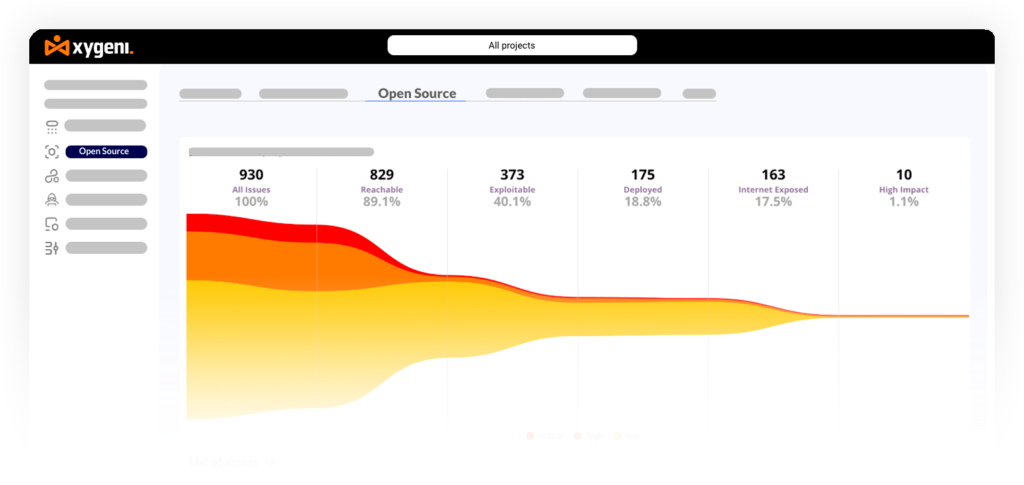Table of Contents
Vulnerability management has long been the cornerstone of ensuring application security. Traditionally, organizations have focused on identifying and patching vulnerabilities to safeguard their digital assets. However, as the digital landscape evolves, so do the threats that lurk within it.
Application Security Posture Management (ASPM) is an innovative approach that analyses security signals across software development, deployment, and operation. Its primary goal is to enhance visibility, manage threats effectively, and enforce controls, thereby enabling organizations to better manage risk.
As applications become increasingly complex, with security tools and responsibilities scattered across various groups, ASPM emerges as a solution to provide a consolidated perspective on application security.
The Evolution of ASPM: More Than Just Vulnerabilities
In the early days of digital transformation, the primary focus was functionality and rapid deployment. As businesses raced to digitize, security often took a backseat. Vulnerability management, the process of identifying and patching software flaws, was the primary defense mechanism. However, as cyber threats grew in sophistication, it became evident that merely patching vulnerabilities was akin to plugging holes in a sinking ship. The need for a more holistic approach was palpable. This realization marked the genesis of Application Security Posture Management (ASPM).
While vulnerability management focuses on identifying and remedying software flaws, ASPM encompasses a broader range of security aspects.
Configuration Management: The Unsung Hero
One of the most overlooked aspects of application security is configuration management. A perfectly secure application can be rendered vulnerable due to a simple misconfiguration. For instance, in 2017, a misconfigured Amazon Web Services (AWS) S3 bucket exposed the personal data of over 198 million American voters. The incident underscored the importance of configuring applications and their associated infrastructure securely.
ASPM tools automate the configuration management process, continuously monitoring applications, tools, and infrastructure for misconfigurations and alerting administrators to potential risks. Businesses can significantly reduce their attack surface by ensuring any configuration according to best practices.
Compliance Checks: Navigating the Regulatory Maze
The digital age has ushered in a slew of regulations aimed at safeguarding user data. From the General Data Protection Regulation (GDPR) in Europe to the California Consumer Privacy Act (CCPA) in the U.S., businesses must ensure that their applications comply with many regulations.
ASPM plays a pivotal role in ensuring compliance. Modern ASPM tools have compliance modules that continuously monitor applications, ensuring they adhere to regulatory standards. It not only safeguarded the company against potential breaches but also against hefty regulatory fines.
Threat Intelligence Integration: Staying One Step Ahead
In the game of cat and mouse, that is cybersecurity, staying one step ahead of adversaries is crucial. Traditional vulnerability management is reactive, addressing threats as they emerge. In contrast, ASPM, with its threat intelligence integration, allows businesses to be proactive.
ASPM tools provide real-time insights into emerging threats by integrating with threat intelligence platforms. It ensures that businesses are not just responding to threats but anticipating them.
Security Policy Enforcement: A Uniform Defense
Ensuring that security policies are uniformly enforced across applications is a monumental challenge, especially for large enterprises with a sprawling application landscape. ASPM simplifies this challenge. With policy managers, ASPM tools ensure that security policies, whether related to authentication protocols or data access permissions, are consistently applied.
By integrating ASPM into the Software Development Life Cycle (SDLC), organizations can enforce a uniform security policy across all their SDLC assets in several ways:
- Centralized Visibility: ASPM tools provide a centralized dashboard that offers a holistic view of the security posture of all applications across the SDLC. It lets security teams quickly identify vulnerabilities, misconfigurations, and non-compliance issues.
- Integration with Development Tools: ASPM solutions can be integrated with popular development tools and platforms, ensuring that security checks are part of the regular development and deployment process
- Remediation: Some ASPM solutions offer remediation support. When a vulnerability or misconfiguration is detected, the tool can provide detailed remediation steps or even automatically fix the issue.
- Consistent Reporting: ASPM tools generate consistent and detailed reports on the security posture of applications. It ensures stakeholders understand the organization’s application security status from developers to top management.
Why ASPM is Crucial in Today’s Digital Landscape
In today’s digital age, businesses are undergoing rapid digital transformation. From e-commerce platforms to mobile banking, applications have become the backbone of modern enterprises.
As businesses increasingly rely on applications to drive growth, the security of these applications becomes paramount, and ASPM will be the compass that guides them toward a secure and prosperous future.
The Business Case for ASPM
Analysis of the business case for ASPM reveals its profound impact on brand reputation, financial stability, and operational resilience. These are compelling reasons why ASPM is an indispensable asset for modern businesses:
Protecting Brand Reputation: In an era where data breaches make headlines, the reputation of a business can be tarnished overnight due to a single security lapse. ASPM ensures that applications are secure, safeguarding the brand’s image and trustworthiness in the eyes of customers and stakeholders.
Financial Implications: Data breaches can result in hefty fines, especially with regulations like GDPR in place. Beyond fines, businesses may face lawsuits, compensation claims, and loss of business, as seen in real-world samples. ASPM acts as a financial safeguard, ensuring compliance and reducing the risk of costly breaches.
Operational Continuity: A security incident can disrupt business operations, leading to downtime and loss of revenue. By ensuring that applications are secure, ASPM ensures operational continuity, allowing businesses to function seamlessly.
Real-world Implications: Case Studies
Delving into case studies provides a vivid picture of the challenges and consequences businesses face in the realm of application security. Some notable incidents that underscore the critical importance of robust Application Security Posture Management ASPM are:
Equifax Data Breach: In 2017, Equifax, one of the largest credit reporting agencies, suffered a data breach that exposed the personal information of 147 million people. The breach was attributed to a vulnerability in an open-source component widely used by Fortune 100 companies in education, government, financial services, retail, and media. The aftermath saw Equifax’s market value drop by $4 billion, and the company spent over $1.4 billion in post-breach costs. An effective ASPM strategy could have identified and remediated the vulnerability, preventing the breach.
Capital One Data Breach: In 2019, Capital One, a major financial institution, suffered a data breach that exposed the data of over 100 million customers. The breach was due to a misconfigured infrastructure supporting a web application. ASPM, with its focus on IaC configuration management, could have prevented such a misconfiguration.
Toyota Several Data Breaches: In June 2023, Toyota disclosed a data breach affecting their customers’ information from February 2015 until May 2023 due to a misconfigured cloud environment. But last year, Toyota also reported that customers’ personal information may have been exposed externally after an access key was publicly available on GitHub for almost five years. Solutions such as Xygeni supporting IaC configuration management and secrets detection could have identified and supported remediating these breaches.
The Strategic Value of ASPM

Businesses face the challenges of rapid technological advancements and the ever-evolving threat landscape. As the digital footprint of enterprises expands, so does the complexity of ensuring application security. It is where ASPM becomes indispensable to provide:
Competitive Advantage: In a market where businesses compete fiercely, ensuring application security can be a unique selling proposition (USP). Customers are more likely to trust and engage with businesses that prioritize security.
According to the latest CISO surveys, 84% of CISOs say they are called into sales engagements related to closing sales of their company’s products, and 96% of CISOs say their prospects consider their organizations’ application security level when making purchase decisions.
Enhanced Customer Trust: With rising data privacy and security awareness, customers prefer businesses that safeguard their data. ASPM ensures that customer data is secure, enhancing trust and loyalty.
Holistic Approach to Security: The modern application environment spans from code creation to cloud deployment. ASPM provides a comprehensive view, allowing businesses to track code throughout its lifecycle. The ASPM holistic approach ensures that vulnerabilities are identified and addressed at every stage, from development to deployment.
Bridging Security Silos: Application and cloud security have historically operated in silos, leading to gaps in the overall security posture. ASPM bridges this gap by collecting and analyzing valuable context about vulnerabilities from both domains. This integrated approach ensures a seamless security strategy that covers all bases.
Reduced Total Cost of Ownership (TCO): While implementing ASPM might require an initial investment, it reduces the TCO in the long run. By preventing security incidents, businesses can avoid post-breach costs, which often exceed the cost of proactive security measures.
From a business perspective, ASPM is not just a security measure but a strategic imperative. Gartner encapsulates the significance of ASPM by highlighting its role in providing broader visibility into application security. ASPM addresses the need for a deeper understanding of applications, the various stakeholders involved in their security, and aligning security practices with the organization’s risk management goals.
The Multifaceted Approach of ASPM: Key Components and Strategies
In the ever-evolving world of software development, ASPM has emerged as a beacon of hope. But what makes ASPM so special? Over the years, ASPM tools have evolved, offering a broader scope of functionality.
Today, through automation, integration, and visualization, ASPM tools empower organizations to navigate the complex landscape of application security confidently.
Core capabilities of ASPM

Some of the core capabilities of ASPM solutions include:
Expansive Coverage: Gone are the days when security was just a checkpoint in the development phase. With ASPM, the security lens broadens. It doesn’t merely focus on the initial stages of application creation but extends its vigilance to CI/CD and cloud environments. Think of it as having a security guard not just at the entrance of a building but patrolling every floor and corner. Whether it’s SCM platforms, CI/CD or cloud infrastructure, ASPM ensures no stone is left unturned.
Orchestrated Testing: Imagine trying to conduct an orchestra where every musician plays their instrument whenever they feel like it. Chaos, right? Similarly, security tools need to play in harmony in the software world. ASPM’s testing orchestration ensures that every security tool integrated across the application life cycle sings in tune. It controls its configuration and operation based on well-defined organizational policies, ensuring a harmonious balance between speed and security.
Guided Remediation: Identifying a problem is half the battle; the other half is fixing it. ASPM doesn’t just stop at pointing out threats. It integrates with workflow tools, like those nifty trouble ticketing systems, guiding teams on potential fixes. It’s like having a GPS for security issues, directing you on the quickest route to resolution.
Data Aggregation and Correlation: In the vast sea of data, finding related pieces of information can be like finding a needle in a haystack. ASPM tools are adept at this. They not only perform one-to-one threat correlations but also group data to represent a complete application, team, or provider. It’s akin to piecing together a jigsaw puzzle, ensuring every piece fits perfectly to reveal the bigger picture.
Prioritization and Triage: Not all vulnerabilities are created equal. Some pose a more significant threat than others. ASPM tools have the intelligence to prioritize these vulnerabilities, threats, and misconfigurations. They assess the risk factors provided by users or inferred from the application, ensuring teams focus their energies where it matters most.
Root Cause Identification: Treating symptoms without understanding the root cause is a temporary fix. Some advanced ASPM tools dive deep, analyzing data from different application components or process steps to pinpoint the root cause of a threat. It’s like a detective piecing together clues to solve a mystery.
Holistic Risk Management: Risk is an inevitable part of business. But with ASPM tools, organizations get a bird’s eye view of the risk landscape. These tools frequently provide an overall risk indicator, helping teams gauge the security health of components or entire applications. It doesn’t just highlight vulnerabilities; it gives them context, helping teams understand the severity and implications.
For example, imagine a dashboard that displays various application components, software providers, or internal corporate development areas, each with a color-coded risk indicator. A green dot could indicate an element with no known threats, yellow could signify moderate risks, and red might highlight critical issues or suspicious activity. A developer introduces a new feature, and the component’s indicator turns green to yellow, or the system raises a notification to the security manager. This immediate feedback prompts the team to investigate, revealing the new feature’s minor data leakage vulnerability.
But ASPM doesn’t stop there. It could further provide insights like:
Historical Data: Showcasing how the risk level of a component has changed over time.
Comparative Analysis: Comparing the risk levels of different organizational components or applications.
Predictive Analysis: Using past data to predict potential vulnerabilities or areas of concern.
Abnormal behavior: Using gathered events to identify activity that deviates from the standard behavior of the teams and automation and could represent an attack attempt.
Furthermore, ASPM tools can integrate with other corporate platforms to make this process seamless. For instance, if a critical vulnerability is detected, an automated alert could be sent to communication tools like Slack or Microsoft Teams, ensuring immediate attention.
Challenges of ASPM Deployment and Integration
It’s essential to recognize that every lighthouse has its shadows. As organizations rush to embrace the benefits of ASPM, they must also be wary of the potential pitfalls that lie ahead. But what are these challenges, and how might they impact the voyage of securing applications?
The Scaling Conundrum: Imagine a library. In its early days, with just a few hundred books, managing and cataloging is a breeze. But as the collection grows into thousands and then millions, the task becomes increasingly daunting. Similarly, as the volume of information associated with application security testing swells, the ASPM system can become overwhelmed.
The challenge here isn’t just the sheer volume but the complexity. Data multiplies with every new application component, integration, tool, or update. If the ASPM solution isn’t designed to scale seamlessly, organizations might find themselves drowning in a deluge of data, struggling to extract meaningful insights. It’s akin to having a state-of-the-art telescope, but its value diminishes if it can’t handle the vastness of space.
Deciphering the Language of Risk: Every organization has its own dialect regarding risk. Some might be risk-averse, treading cautiously with every decision, while others might be more adventurous and willing to take calculated leaps. The beauty of ASPM lies in its ability to identify and respond to security issues. But this assumes a crucial factor: the organization must fluently speak and understand its risk dialect.
If an organization deploys ASPM without clearly understanding its risk tolerance, it’s like setting sail without a compass. They might have the most advanced ship (ASPM tool), but without direction, they could drift aimlessly or head straight into a storm.
The Integration Puzzle: Integration is the glue that binds the ASPM solution to an organization’s existing infrastructure. But here’s the catch: not all glues are created equal. While ASPM promises broad integration capabilities, the reality can be mixed. Different vendors offer varying scopes of integration and functionalities.
Think of it as trying to fit pieces from different jigsaw puzzles together. Some might fit perfectly, others might need a bit of force, and some might not. If the ASPM solution doesn’t integrate seamlessly with existing tools, platforms, and processes, it can create gaps in the security posture. It’s like having a fortified castle with a state-of-the-art security system, but the entire fortress is at risk if the main gate doesn’t close properly.
Conclusion and final remarks
Application Security Posture Management (ASPM) emerges as a guiding star in the vast ocean of software security. It promises a consolidated view of application vulnerabilities and software supply chain threats, a symphony of orchestrated testing, and a compass for risk management. But as with any voyage, there are potential storms to navigate. The challenges of scaling, understanding risk dialects, and ensuring seamless integration can test the mettle of any organization.
However, these challenges aren’t insurmountable. With a clear understanding of one’s risk landscape, a commitment to integration, and a forward-thinking approach to scalability, organizations can harness the full power of ASPM. It’s about recognizing that while the tool is powerful, its true potential is unlocked when tailored to an organization’s unique needs.
Charting the Course Forward
As we stand at the crossroads of innovation and security, the call to action is clear: Embrace ASPM, but do so with awareness and preparation. Dive deep into its capabilities, understand its potential pitfalls, and chart a course that aligns with your companys’s goals. In this ever-evolving landscape of threats and solutions, let ASPM be your trusted ally, guiding you toward a future where applications are not just functional but secure.
So, to every organization looking to fortify its software defenses: Set sail with ASPM, but ensure you have the right maps, the right crew, and the right mindset to navigate the journey ahead. The horizon of secure software awaits!






